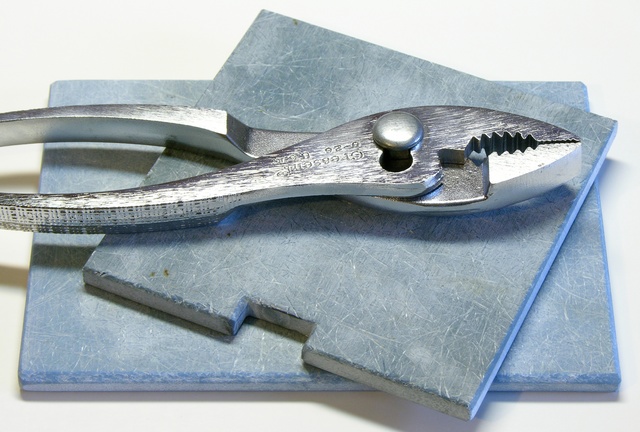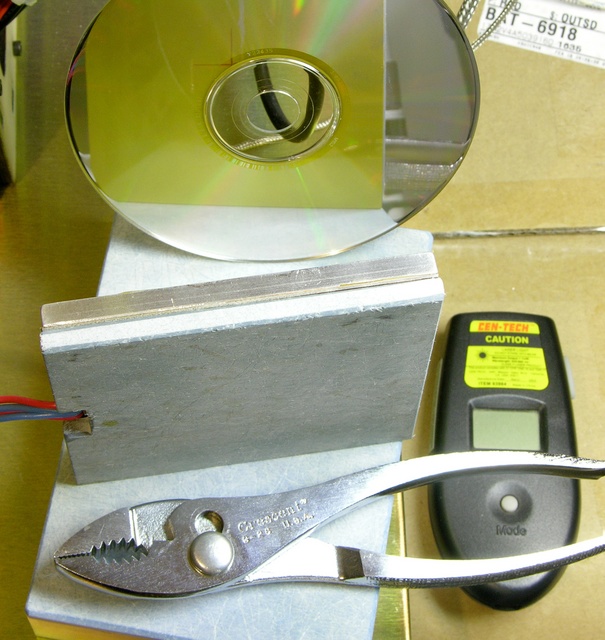I got a care package this week from my friend Scott in San Diego. Half of it was two pieces of Glastherm HT that he cut to fit my soldering hotplate and my MakerBot CupCake heated build platform. Scott and his buddy Ben Wynne are building hotplates and were also planning to use Glastherm to insulate them.
Last night I pried the warped acrylic off the underside of my platform, cleaned the surfaces with alcohol to ensure a good stick, and affixed the Glastherm to the heater PCB with kapton tape. I then set the assembly on edge on another piece of Glastherm and ran it up to operating temperature.
The Glastherm was not nearly as good an insulator as I expected. The “cold” side of the sandwich lagged only 25°F behind the hot side as I was heating it from room temperature and once it stabilized at 250°F, (at which point the “cold” side reach equilibrium around 225°F).
I’m surprised that the Glastherm provided so little insulation. Perhaps it’s not intended to be used in direct thermally-conductive contact with a hot surface — although the diagram on their web site certainly suggests that it is.
At any rate, the “cold” side of my sandwich is still far too hot to be in contact with my acrylic mounting plate. And since Glastherm is supposed to be pretty good stuff, I think I’m resigned to finding a way to assemble my sandwich that leaves an air gap between the heater and the mounting plate, which I hadn’t wanted to do.


I’d suggest re-running your experiment with an test piece of acrylic on the ‘cold’ side, as per your original mounting plan, just to be sure that the measured temperature is really an indicator of a problematic amount of thermal energy.
Honestly, I don’t know what will happen to the acrylic, but I do know that readings from a high impedance sensor like your thermometer can be misleading when dealing with insulated heat sources — much like using a very high impedance digital multimeter on transient voltages.
Insulation is all about retarding the movement of heat energy, temperature (like voltage) by itself does not give you the full picture of how much damaging heat energy there actually is at the face of your insulation…
Try touching the ‘hot’ Glastherm with your finger for a quick and dirty experiment (although maybe not at your heater’s full operating temperature — just to play it safe…
Aw, Leon, there you go reminding me that I’ve forgotten everything I learned in my college thermodynamics class. Thanks a lot!
Seriously, I did consider that temperature alone doesn’t tell the whole picture and it’s thermal conductivity and heat transfer that matter. Your impedance analogy is elegant and excellent, and I’ll remember that for future explanations!
I know that getting acrylic to “sag” or warp takes much less heat than getting it to melt, because it doesn’t involve a phase/state change from solid to liquid. Where my weak knowledge of thermo fails me is this: Are we basically comparing the thermal conductivity (impedance) of the Glastherm to that of the acrylic? If the acrylic is (enough) more thermally conductive, then what heat leaks through the Glastherm will dissipate out the edges of the acrylic without melting it? If the acrylic isn’t conductive enough, then what heat leaks through the Glastherm will build up in the acrylic and warm it enough to sag/warp?
I ran another test last night, with the heated platform sitting in its desired orientation on top of a loose piece of plexiglass on top of my spare Glastherm (like the acrylic mounting plate sitting on the Y stage).
After running it up to target temperature, I picked up the heater “sandwich” using a pair of pliers on a corner of the plexi, and the plexi sagged significantly — it was quite warm. Too warm, I conclude, to use with my real acrylic mounting plate in the real machine.
Oh dear, sorry to hear that… The Glasstherm sandwich was such an elegant solution — I really wanted it to work for you!
I’m not sure exactly how you would implement it, maybe some sort of shallow tray or mixed with high temp epoxy, but Aerogel
http://unitednuclear.com/index.php?main_page=product_info&cPath=16_17_69&products_id=89
Would be a great substance, the link above it is pretty cheap, although in granular form. I guess the solid sheets are still pretty pricey.